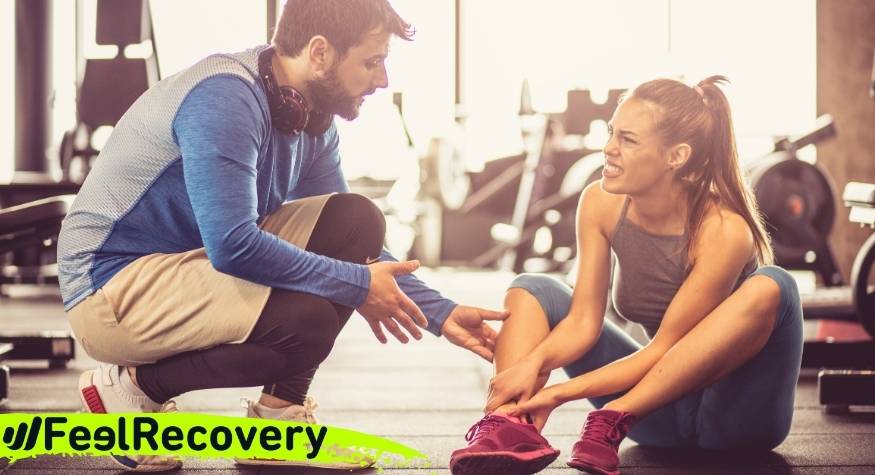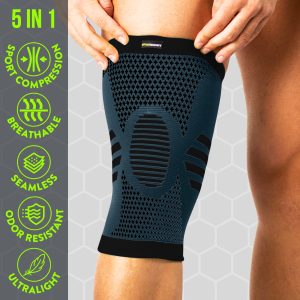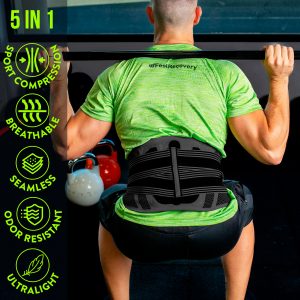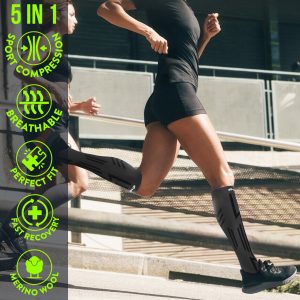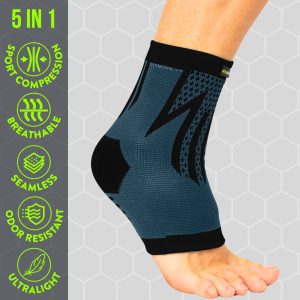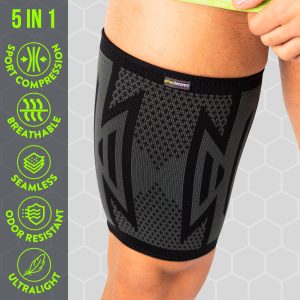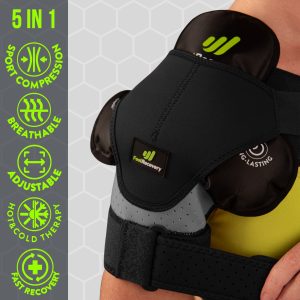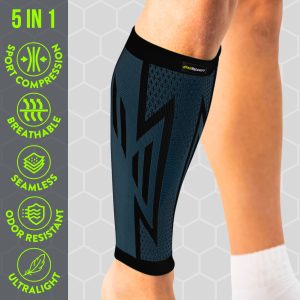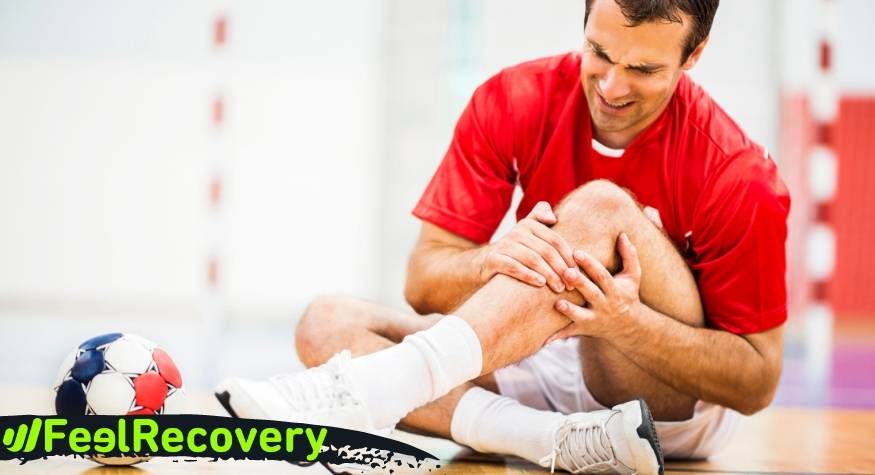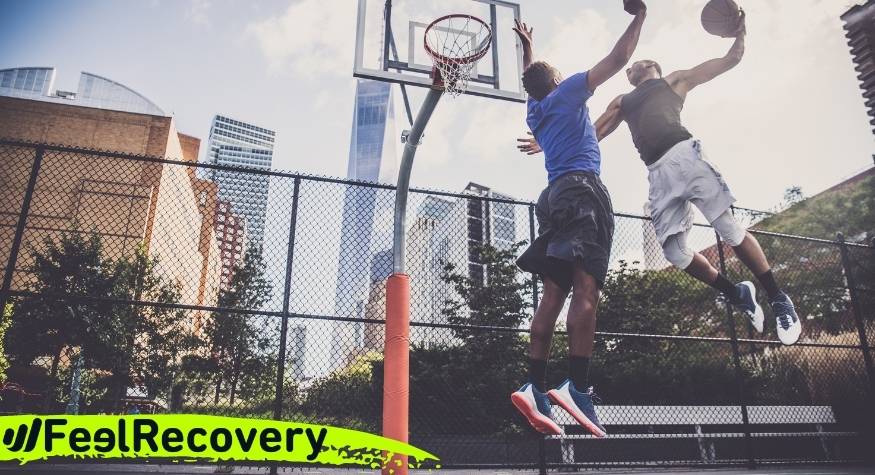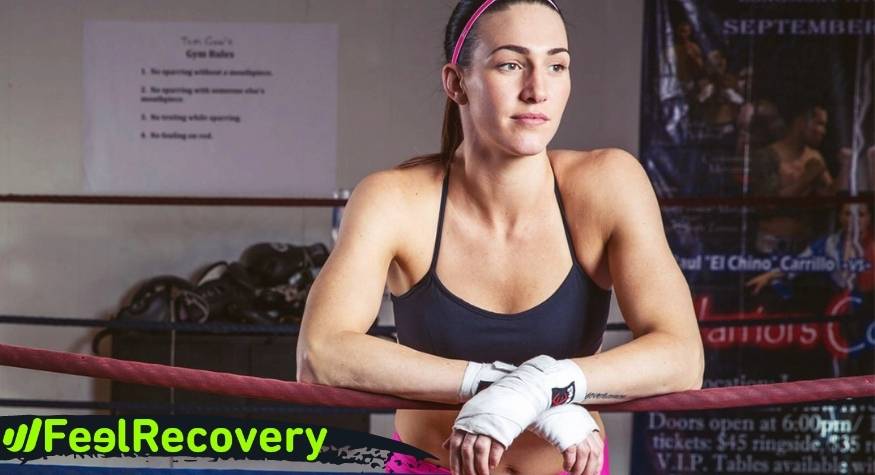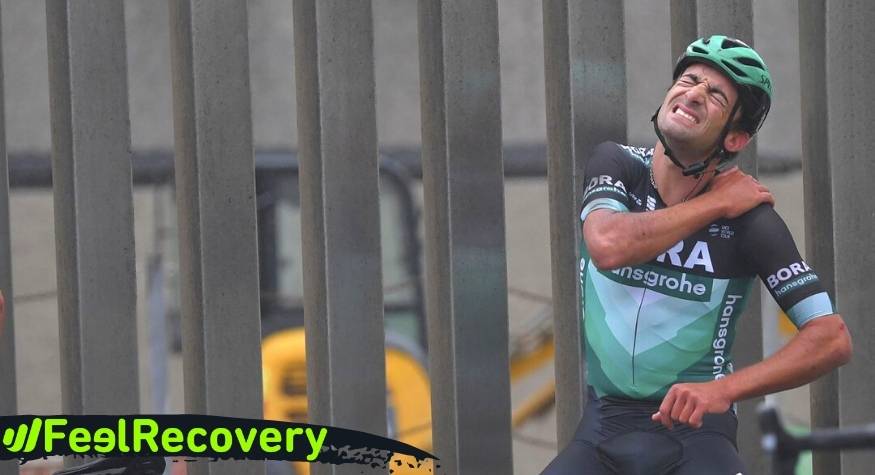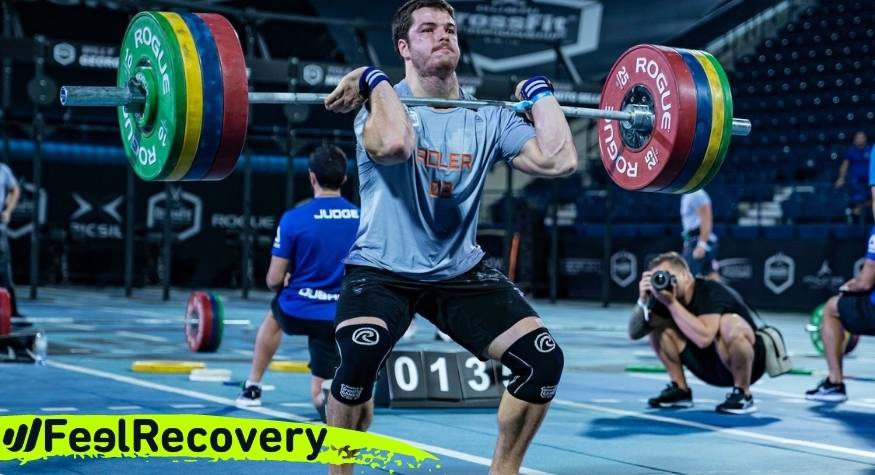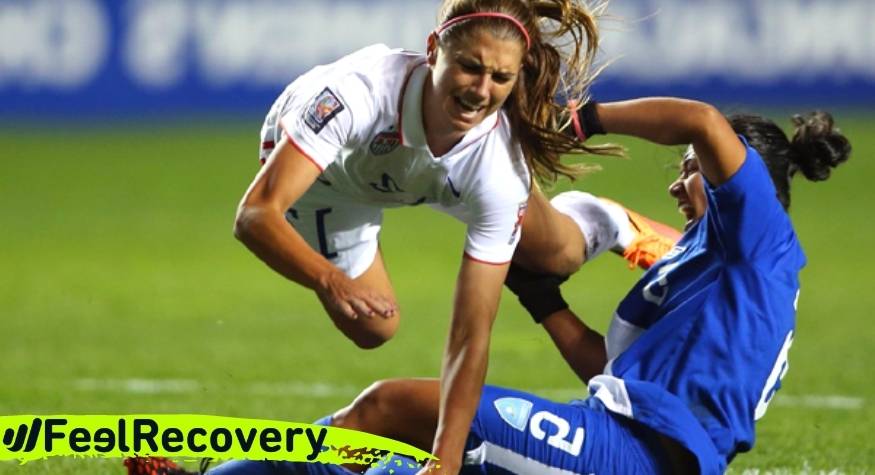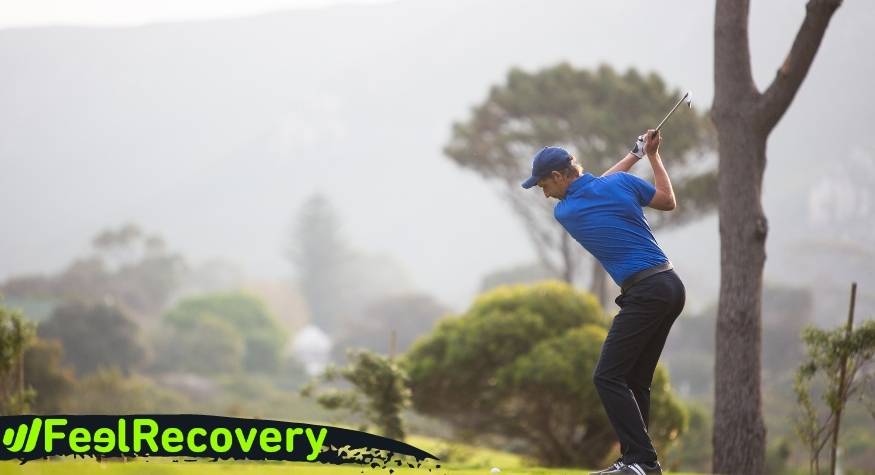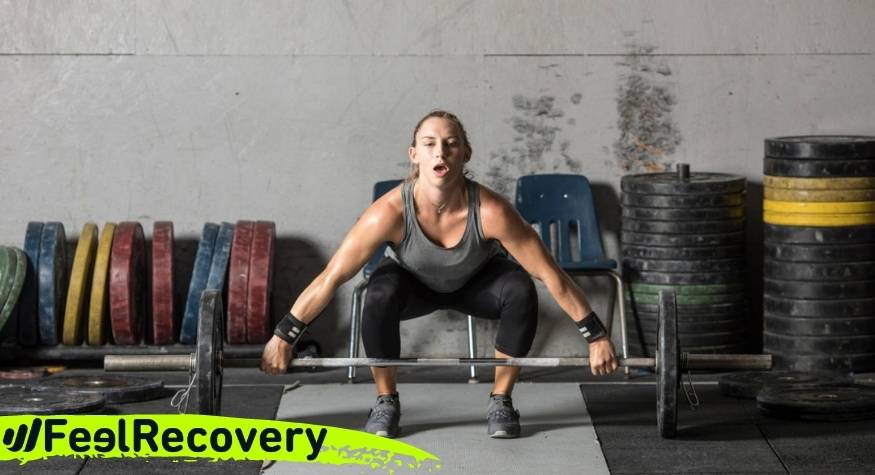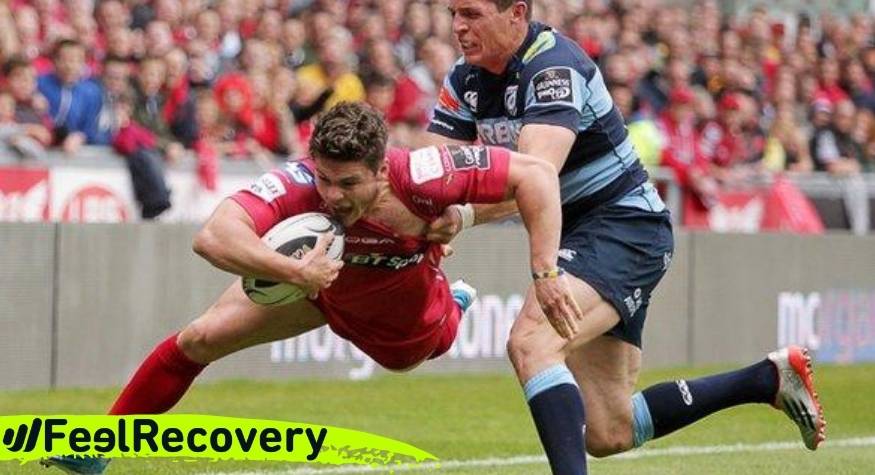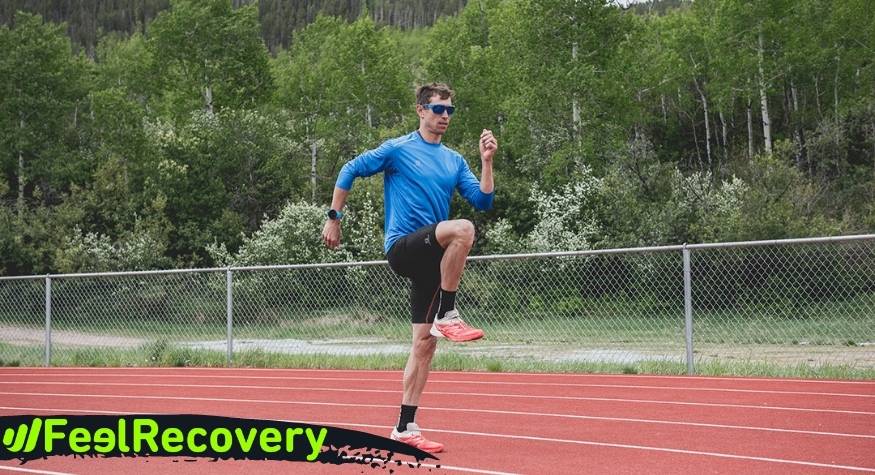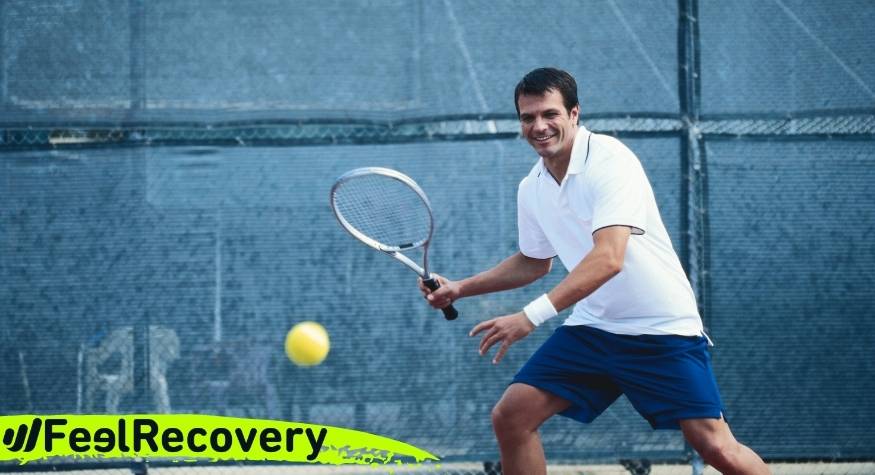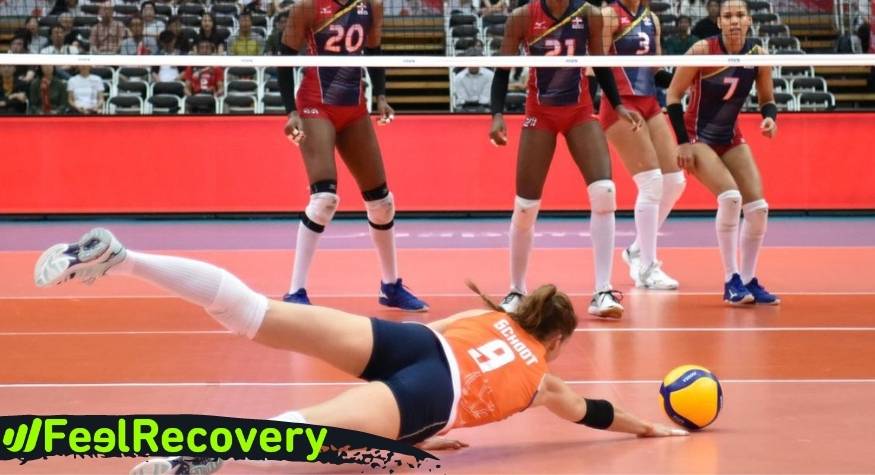In any sporting activity there is a potential risk of injury, whether to muscles, bones or tendons. Even in sports considered low-impact like golf, tears, strains and sprains are likely to occur. Do you know what to do in the event of a strain? Find out what steps to take in the first few minutes of an injury.
In this article you will learn what kind of injuries you can get when playing sport, as muscle, tendon and joint discomfort are more common than you think. You'll find out the most common causes of sports injuries and we'll give you a breakdown of injuries by sporting discipline.
Definition: What are sports injuries?
A sports injury is any injury that arises either from trauma, from poorly performed exercise or extreme training, or even from wear and tear on the soft tissues through years of playing a particular sport. Most of these injuries are generated in training, so it is important to take all possible preventive measures to avoid them.
What types of sports injuries can we suffer from?
There are several ways of classifying sports injuries, but the most commonly used are according to the injured tissue and according to their severity. Below we explain each of these classifications in detail.
Classification according to the tissue affected:
More than 60% of sports injuries are produced in the soft tissues bursitis are the most common injuries to the , as a result of the high stress that muscles, joints, ligaments and tendons receive in training and competitions. The best way to prevent them is to take into account muscle warm-up, good hydration and nutrition, good cooling and proper physical and mental preparation, which will vary according to the discipline you develop in your life.
Muscle injuries
Muscles are the main engine of human movement. Direct blows, repetitive and sudden movements, or lack of adequate physical preparation, will make them unable to withstand the demands of the sport you do and suffer some of the injuries shown below:
- Cramps: is a colloquial way of calling mild muscle contractions, lasting just a few seconds until the fibres relax and return to their usual shape. It is not an injury that will affect your performance for more than a day, but it is a warning that the muscle is reaching its limit and needs rest.
- Contractures: is a discomfort that arises from muscle overwork, it is the inability of the fibres to relax. When this happens, they remain tense for several minutes or even hours. At this level there is pain and difficulty in moving the affected limb.
- Contusions: these are blows to the muscles that cause various reactions depending on their intensity: from bruising to pain and inflammation. They are common in contact sports such as boxing and karate. As it is a soft tissue injury, the approach is through the PRICE method, which you will also learn in this article.
- Strain: this is a sudden and extreme stretching of the muscle fibres. It is also known as elongation, when it exceeds the muscle's ability to stretch. When it occurs, a stabbing pain is felt in the affected muscle, usually forcing the athletic activity to stop.
- Ruptures and tears: are used to describe when the fibres of a muscle are torn due to overloaded tension or sudden movements. The pain becomes more intense and full recovery is more complex because in the most severe cases surgery is required.
- Total rupture: this is when the muscle ruptures completely and makes it impossible to move the affected limb. In the previous injury the rupture is partial, perhaps minimal, but in a total rupture the muscle fibres cannot regenerate on their own and by means of arthroscopy they must be repaired by suturing them so that they begin the process of regeneration in a natural way.
Tendon injuries
The job of the tendons is to hold the muscles to the bones, being of great importance to give stability to the joints. Although they are soft tissues, they are quite resistant and manage to perfectly transmit the force generated by the muscles to the bone structure.
- Enthesitis: this is a punctual injury at the junction of the tendon with the bones. Inflammatory processes cause a pathological change in this fibrocartilaginous junction to the point of causing intense pain.
- Tendinitis: this is the irritation and inflammation of the tendon fibres due to exceeding their natural capacity for elasticity. With tendonitis, rest and patience are key because if it becomes recurrent, it will be more difficult for the tissue to fully regenerate and you will need to be off work for longer and longer.
- Partial rupture: this is when the fibres of a tendon are fractured without breaking completely, which is generally caused by a sprain of the joint or simply by a strong direct blow to the cord. The most common ruptures occur in ankles, elbows and knees.
- Complete rupture: When there is a complete rupture of the tendon, only surgery can repair the damage and the return to physical activity will be slow, after physiotherapy sessions. It is an injury linked to the experience of the athlete, as it is older people who tend to have the weakest tendon tissue.
- Dislocations: if the tendon moves from its usual place, then a tendon dislocation occurs and requires recovery based on rest and drugs. Of the tendon injuries, this is the least common unless there is a bony dislocation.
Joint injuries
Joints are essential for any athlete, and each discipline demands one or the other to a greater or lesser extent. This is why it is quite common for the vast majority of serious injuries to occur in them, despite the fact that they are generally quite reliable in terms of resistance.
- Bursitis: Bursae are small sacs that cushion friction and shock in the joints. They are filled with fluid, but when they become irritated, the body produces more than they can handle, causing inflammation that leads to acute joint pain.
- Synovitis or membrane inflammation: begins with inflammation of the synovial membrane that covers the entire joint for extra protection against bruising and friction. The membrane becomes inflamed after being irritated by bad posture and strong movements.
- Cartilage damage: most commonly, cartilage inflammation, deformation of the cartilage structure and wear and tear due to years of sporting exercise. Unlike other tissues, cartilage does not have the ability to regenerate itself, so it is important to take care of it.
Bone injuries
Of all sports injuries, bone injuries are the most problematic because of the pain they cause and the time it takes to make a good recovery. Long bones, such as those in the leg and arm, are the most prone to damage in the sports area.
- Periostitis: this is the inflammation of the periosteum, a membrane that covers the bone structure and is injured by strong blows and intense muscular contractions that cause micro-traumas. A good rest is usually enough to alleviate the discomfort.
- Dislocations: the ends of bones are connected to other bones by joints. If a bone slips out of place, it is a dislocation, which can be partial or total. This causes severe localised pain and inflammation of the surrounding tissues.
- Fissures: this is a small fracture in the bones, such as one or several lines visible on X-rays that confirm the damage. Often there is no pain because the bone does not actually move out of place.
- Fractures: these can be single or multiple, where there are several loose pieces on the inside that cause collateral soft tissue damage. If there is damage to the tendons and muscles, surgery is performed, otherwise immobilisation of the limb is sufficient.
Classification according to severity:
The type of injury according to its severity is going to be linked to other indicators such as the intensity of pain, whether it is an open injury or if there are deformities in the joints and limbs as a result of trauma. Take a look at this classification of injuries you may be exposed to when playing sport.
Minor injuries
These are soft-tissue injuries that do not require a long recovery period and do not affect the athlete's muscle function and performance for more than a few days.
Among the most important ones we can mention:
- Cramps.
- Contractures
- Contusions.
- Muscle overload.
- First degree sprains.
- Bursitis.
Severe or acute injuries
These are injuries that occur at the moment of physical exercise due to specific accidents during training or competition.
Among the most common are the following:
- Strains.
- Second and third degree sprains.
- Tears.
- Ligament ruptures.
- Bone fractures.
Chronic injuries
These are injuries caused by wear and tear in the soft tissues due to playing sports for many years or, failing that, to genetic factors that favour this degeneration. If a sport is of high intensity, this increases the possibility of being chronically injured.
Among the most common are:
- Plantar fasciitis.
- Arthrosis.
- Chondropathies.
- Tendinitis.
- Cartilage degradation.
Best products for sport injury
Bestseller
What are the most common causes of sports injuries?
Believe it or not, carelessness and overconfidence on the part of the athlete are factors that trigger injuries. Thinking that the body will never suffer any damage pushes the athlete to not prepare his body properly and to suffer more injuries than usual.
- Lack of warm-up: before intense training, the body must be prepared to take on the intensity of physical exercise. It consists of giving mobility to the joints and facilitating the flexibility and elasticity of muscles, tendons and ligaments, all important components in the athlete's performance. When we do not warm up the body, we increase the likelihood of cramps, contractures and fatigue in the muscle fibres until they give way, become inflamed and irritated, making them more susceptible to injury.
- Omitting to cool down: a proper cool-down consists of low-intensity exercise that helps the body regulate its vital signs. Blood pressure and heart rate should return to a calm state. The muscles must relax completely and promote the recovery of their cells after the wear and tear of training. Only a good athlete knows the importance of preparing his body and making it ready for future training. This avoids muscle discomfort, stiffness and injuries due to the wear and tear of exercise.
- Physical overload: overtaxing your body is a mistake. Whenever you train, you should always stick to a training schedule that is tailored to your abilities and the achievement of specific goals. An overload of muscular tension will only cause the tissues to fatigue and all the sporting pressure will fall on the joints and bones, resulting in sprains, dislocations and fractures. How to detect an overload? You will feel accumulated fatigue, the tissues are tense even when you are at rest and you find it difficult to recover from muscular stress.
- Lack of rest: the body needs to regenerate damaged cells and tissues. These regenerate at their own pace and we should not force them, although non-invasive therapies can help the body to recover better. For minor injuries, rest can last up to 72 hours with the help of the PRICE method. But when it exceeds this time, it is important to seek the advice of an orthopaedic surgeon and sports doctor.
- Use of inadequate equipment: Many sports injuries are caused by the use of footwear that is in poor condition, does not fit the athlete's size and is not the correct type of footwear for the discipline being practised. In strength sports, such as weightlifting, using a belt that does not support the lower back properly will cause the lower back muscles to suffer more. As you can see, each sport has its own type of equipment that complies with a set standard and rules. Be clear that the equipment you use in training is the same equipment you should use in competition.
- Ignoring your body: Before a chronic injury, there will always be a minor injury that warns the athlete that something is wrong with their body. When the initial discomfort is not attended to, then the body responds with a major injury. Some 90% of athletes have suffered injuries at some time in their lives, so you must prevent all injuries and their recurrence, because a minor injury that is poorly treated can become chronic.
- Bad technique: not having good technique increases the chances of injury to the body because the force transmitted over-stretches the muscles, twists the joints unduly and places a greater workload on the bones to maintain stability. You should always practice under a reasonable workout schedule, focused on your needs and with specific routines that develop each part of the body.
- Inadequate hydration and nutrition: not following a diet that allows you to ingest the necessary calories for sports practice, both in macronutrients and micronutrients that your body requires, will mean that joints and soft tissues will not be able to perform a demanding training or physical activity. Similarly with hydration, water allows nutrients to be better absorbed through the bloodstream, improving your health.
What are the most common types of sports injuries in each sport?
Whatever sport you do, whether it is an endurance, strength or explosive discipline, muscle, tendon and ligament injuries are the most common. But depending on the type of effort, injuries to these tissues originate in different parts of the body.
Badminton sports injuries
As in all racket sports, injuries are concentrated in the extremities. Badminton is the fastest sport of its kind as the shuttlecock can travel at over 300 km/h and this requires incredible strength in the stroke.
- Shoulder injuries in badminton : Tendinitis and bursitis are the most common injuries to the most mobile shoulder joint. They are caused by the repetitive movements of the racket stroke and are aggravated by poor badminton technique.
- Knee injuries in badminton : The most common are meniscus injuries and anterior cruciate ligament tears. Both are caused by the dynamics of starts, stops and sudden changes of direction. Muscle wear and tear increases the likelihood of these injuries.
- Ankle injuries in badminton : The ankles take the full load of the body, so the most common injuries are Achilles tendonitis and bursitis due to the constant rubbing between the internal components of the joint.
Sports injuries in basketball
This sport is physically demanding on the lower limbs, which is why more than half of the ailments are concentrated in the legs, either in the ankles, feet or calves. In addition, due to the great weight and height of basketball players, the joints are more exposed to mishaps.
- Foot, ankle and leg injuries in basketball : Muscle contractures, tendonitis, and plantar fasciitis are the hallmark ailments of the sport. The constant jumping, pivoting, starting and stopping cause severe wear and tear on the legs until they collapse.
- Knee injuries in basketball : Cartilage wear and tear is an ailment of every veteran athlete. Even if the necessary precautions are taken, there will always be discomfort in the joint due to cartilage injuries and inflammation of the meniscus.
- Hand and wrist injuries in basketball : Although in a low percentage, there are injuries to hands, fingers and wrists as a result of improper ball handling. Receiving a pass at high speed wears down the ligaments and tendons in both parts of the body to the point of cracking or spraining fingers.
Sports injuries in boxing and contact sports
Most injuries are caused by the boxer constantly hitting his opponent. It is important for the boxer to be aware of his technique to avoid injury.
- Shoulder injuries in boxing : The rotator cuff is the most affected muscle group, especially the supraspinatus muscle. Repetition is key to understanding how to achieve a punch that is effective and does not alter joint function.
- Neck, head and face injuries in boxing : Strong blows to the head generate various ailments in the cervical spine such as displaced discs. In addition, bruises and skin cuts are frequent. That is why the boxer protects his face in the first place.
- Hand and wrist injuries in boxing: The force of a direct blow in boxing exceeds 700 kilos of pressure. Although the intention is to injure the opponent, the hands and wrists are also injured and even have bone cracks.
Sports injuries in cycling
Ailments in cycling are silent until they have progressed to a certain degree. It is advisable for the cyclist to pay attention to discomfort in the legs, lower back and shoulders, and if you are a novice cyclist, pain caused by the position on the bike will be common.
- Shoulder and wrist injuries in cycling: Any part of the shoulder will become inflamed if the body weight is not balanced, so the saddle height should be checked. Wrist discomfort is caused by the force of the grip on the handlebars. Falls are the main cause of serious collarbone injuries in cycling.
- Back and lumbar injuries in cycling: Forced positions of the cyclist cause the back muscles to contract excessively. There must be correct alignment between the saddle and the handlebars, the fit must be customised to the cyclist's biomechanics.
- Knee and leg injuries in cycling: Muscle overload on the biceps femoris is the most frequent cause of these injuries. The constant movement of the knee also causes the meniscus to wear out. A good warm-up of the body before pedalling and complementary strengthening exercises are recommended.
Sports injuries in Crossfit and strength sports
No two Crossfit routines are the same, they all have a different purpose although they all focus on developing greater strength and muscular endurance. In Crossfit, the change in sporting intensity is the trigger for injuries, in addition to the accumulated fatigue after several training sessions.
- Shoulder injuries in Crossfit: The high demand causes the shoulder tendons to be overstretched, especially those that make up the rotator cuff. Due to the constant repetition and strain on the shoulder, the tendons become irritated and can rupture.
- Back and lower back injuries in Crossfit: 36% of Crossfit injuries occur in the lower back. Muscle contractures are common, as are slipped discs in the back from lifting heavy weights with improper technique.
- Knee injuries in Crossfit: Poor technique and excessive bending cause the hamstrings in the knees to over-stretch. Also, in Olympic lifts, the knees take the full weight of the body, so an imbalance will lead to sprains and dislocations.
Sports injuries in climbing and mountain sports
As with other sports, mountain climbing requires training based on strength and technique development. Whether you're just out for a walk in the mountains or you're interested in climbing big rock faces, you're never going to be safe from injury.
- Shoulder injuries in climbing: Muscle strains and dislocations in the shoulder are the most recurrent ailments in mountaineering, because it is common to be left with the body sagging and being held only by the hands while we move forward or even that the legs slip and the arms have to support the whole body.
- Hand, finger and wrist injuries in climbing: Dislocations and fractures in hands and fingers will always be at risk when climbing a mountain, either due to the weight of the body when we depend on the arms or due to unexpected falls.
- Knee injuries in climbing: As a result of muscle fatigue, joints do not respond as they should and their soft tissues become inflamed. The greatest bodily strain occurs in the legs so they must be strong and resilient.
Sports injuries in football
Football is considered a high-impact sport because of the intensity with which athletes play. Obviously, most injuries occur in the lower extremities, whether it's the ankles, knees or calves.
- Calf injuries in football: The calf muscles are located at the back of each leg and the main cause of injury is muscle contractures or heavy blows during play.
- Foot injuries in football: Fractures in the metatarsal bones will always be a risk for football players, even more so when they do not have a good technique for striking the ball. Opponent's footsteps on the foot also cause the phalanges to fracture or crack.
- Ankle injuries in football: In addition to classic sprains, ankle sprains are a recurring ailment due to changes of direction while the foot remains fixed to the ground. In addition to falls on the foot that excessively strain the ligaments.
- Hip injuries in football: Groin strains affect players running from midfield, manoeuvring to avoid opponents or striking the ball. The musculoskeletal coordination to achieve all this takes players to extremes resulting in the dreaded pubalgia.
- Knee injuries in football: Ruptured anterior cruciate ligament is the most feared injury for football players as it will keep them off the field for several months. Despite good physical preparation, the knees take all the strain on the pitch.
- Leg injuries in football: In general, athletes should take care that there is no muscle fatigue in the muscular structure, they should prepare their bodies before training and during matches. A good warm-up and cool-down will reduce the likelihood of injury.
Sports injuries in gymnastics and rhythmic gymnastics
In both the upper and lower extremities, muscle overloads, sprains, contractures and joint damage are quite frequent in rhythmic and sport gymnastics due to the strong impacts on the joints in this sport discipline.
- Hand and wrist injuries in gymnastics: In gymnastics, the most common hand injuries are minor sprains and in the most severe cases sprains occur, this is because the wrists have limited mobility and gymnastics takes them to the extreme.
- Back injuries in gymnastics: Muscle contractures and lower back pain are the most common complaints. There are twists and postures in gymnastics that force the body to perform unexpected and intense movements, pushing the spine to its limits.
- Injuries to the feet and ankles in gymnastics: These are often caused by gymnasts falling during training and competitions. Training will reduce the likelihood of injury, although lack of concentration in routines has a negative impact on performance.
Sports injuries in golf
95% of golf injuries are caused by the swing, i.e. the stroke of the golf ball in search of a hole in one. During this movement, all the muscles and joints of the body are activated with great explosiveness, which can lead to various injuries.
- Shoulder injuries in golf: The subscapularis muscle is the most commonly injured muscle due to the sudden movement of the shoulder in search of greater force with the club. The constant repetitions fatigue the fibres and cause muscle micro-tears.
- Back and lumbar injuries in golf: Having a bad posture and being in an irregular terrain will make the back feel a greater intensity at the moment of the stroke. If the golfer exerts more force, the injury will be more severe.
- Knee injuries in golf: Having the foot fixed to the ground and exerting an intense twist will cause the internal lateral ligament of the knee to swell due to the overload of this tension. Technique must be considered if you want to hit the ball from uneven ground.
- Hip injuries in golf: The hip turn will help the shoulders to rotate the golf club correctly and transmit more force into the shot. Hip pain is one of the most common ailments that afflict golfers.
- Hand and wrist injuries in golf: The heavy pressure of the hands on the club and the twisting of the wrists puts too much strain on the tendons and ligaments, so tendonitis is common in golfers, as well as torn ligaments.
- Elbow injuries in golf: The best known in the world is "golfer's elbow", which involves damage to ligaments, tendons and muscles on the inside of the elbow. This is due to the constant stretching of the elbow tendons that occurs during play.
Sports injuries in weightlifting and gym sports
Weightlifting is a sport of extreme strength and maximum explosiveness in its movements. Like Crossfit, injuries are linked to the overload of work on the joints and the different muscle groups of the arms and legs.
- Elbow injuries in weightlifting: Slight imbalances of the body while lifting cause the ligaments and tendons in the elbow to shift and give way under the extreme weight. This results in irritations, tendonitis and sprains.
- Knee injuries in weightlifting: They bear the full weight of the body and the weight of the weightlifting bars, which can be twice the weight of an athlete. A slight false move will cause the meniscus to become inflamed, fractures are also possible.
- Back injuries in weightlifting: The lower back is susceptible to injuries such as muscle contractures and slipped discs. That is why it is mandatory to wear a seat belt in weightlifting and power sports training and competitions.
Sports injuries in rugby
Although rugby is by nature a high impact contact sport, the injuries that receive the most attention are generated by the wear and tear on muscles and tendons. All other injuries are due to trauma and falls.
- Neck injuries in rugby: The constant bumps and jerky movements cause the cervical discs to shift and put pressure on the nerves. This is almost inevitable in rugby, and it is up to the player to be careful of trauma.
- Knee injuries in rugby: The anterior cruciate ligament and posterior cruciate ligament of the knee take the brunt of the force and pull on the legs in a rugby match. It starts with inflammation and can lead to ligament rupture.
- Shoulder injuries in rugby: Collarbone injuries and dislocations from tackles during the game are common. Rugby combines the intensity of soccer with the strength of wrestling.
Sports injuries in running
Wear and tear on the lower limbs will cause a runner to have a wide variety of chronic injuries, i.e. present for years of training and the number of kilometres on their legs.
- Ankle injuries in running: The ankle allows traction and stability of the body, in long distance runners, these tendons are prone to inflammation and tendonitis. In addition, poor stride leads to ankle sprains.
- Calf injuries in running: The calves are muscles that support a large part of the runner's weight and when there has not been a good warm-up, muscle pulls and micro-tears in their fibres can occur.
- Foot injuries in running: Blisters on the feet are an annoying reality that every runner has suffered at some time, these blisters can even bleed. In addition, the fascia of the sole of the foot can become inflamed from overtraining.
- Hip injuries in running: When we walk or run on uneven terrain, or have a bad running technique, we can suffer from hip injuries due to imbalances in our repetitive movements.
- Knee injuries in running: When the muscles in the knee swell and tighten, they cause friction in the joint until the bursae and tendons collapse. This is known as "runner's knee".
- Running leg injuries: In general, any muscle can suffer from wear and tear and fatigue from too many days of training and too little rest. As the muscle is fatigued, the workload falls more heavily on the ligaments, bones and tendons.
Sports injuries in tennis
Tennis is a very popular sport among amateurs, and in combination with repetitive movements and lack of physical preparation, injuries are present in the upper and lower extremities if there is no good physical warm-up.
- Tennis ankle and foot injuries: Sprains and strains are common tennis injuries due to stops, starts and changes in body direction during a tennis match.
- Shoulder injuries in tennis: Inflammation of the muscle group in the rotator cuff begins with a pinched joint, then the suprascapular muscle ruptures, limiting the tennis player's movement.
- Back and lower back injuries in tennis: Muscle contractures and hamstring inflammation can be avoided if the player has good technique, along with balancing the body so that the back and abdomen share the workload.
- Tennis elbow injuries: Lateral epicondylitis, or better known as "tennis elbow", is an injury caused by repetitive racquet ball striking. It is a wear-and-tear injury that requires close attention.
- Hand and wrist injuries in tennis: The grip of the hand on the racket will define this type of injury. Care should also be taken with the hitting technique to avoid tendon inflammation and sprained fingers.
- Knee injuries in tennis: Inflammation of meniscus, ligaments and tendons have a high incidence in tennis players due to sudden twisting of the knee during training and matches, especially when playing tennis on hard surfaces.
Sports injuries in volleyball
Trunk and upper limb injuries are concentrated in volleyball, whether it is played in a sports hall or on the beach. Excellent fitness will lower the injury rate.
- Shoulder injuries in volleyball: Tendons in the rotator cuff and biceps brachii are more prone to overstretching and partial rupture. These are also soft tissue fatigue injuries.
- Hand and finger injuries in volleyball: These are traumatic injuries, i.e. caused by the ball hitting the fingers and hands. Broken phalanges are recurrent in this sport.
- Ankle injuries in volleyball: As the player is constantly making high intensity jumps and changing direction in search of the ball, the ankles support all these impacts and in a bad fall, these ligaments are twisted and sprains can occur.
Yoga sports injuries
Yoga offers a wealth of benefits to the body and mind, the basis of which is slow, coordinated movements and breathing. However, it is also likely that you will suffer from muscle injuries.
- Yoga neck injuries: These are related to muscle stiffness during the practice of Yoga exercises and the omission of warming up before doing the first body positions.
- Yoga shoulder injuries: Pushing the shoulder joint to the extreme leads to muscle strain and tendonitis. Always take into account your body's limitations before trying new postures.
- Ankle injuries in Yoga: Transitions between Yoga postures cause the tendons and ligaments of the ankle to become overstretched. Avoid sudden movements, in Yoga the muscles remain relaxed.
- Back injuries in Yoga: Having a sedentary life and starting to practice Yoga makes the back start to ache, especially in the lumbar area. Practice and continuity will allow more flexibility and elasticity in this area.
- Hip injuries in Yoga: When we are not careful in the movements and physical capacities of each person, the cartilages of the hip wear out and the friction in the joints starts producing pain.
- Hand and wrist injuries in Yoga: When we do not execute a good Yoga posture, the weight of the body falls more on the wrist and not on the whole hand. All the soft tissues in the wrist become inflamed.
F.A.Q: Frequently asked questions
References
- Maffulli, N., Longo, U. G., Gougoulias, N., Caine, D., & Denaro, V. (2011). Sport injuries: a review of outcomes. British medical bulletin, 97(1), 47-80. https://academic.oup.com/bmb/article/97/1/47/358051
- Peterson, L., & Renstrom, P. A. (2019). Sports injuries. CRC Press. https://www.taylorfrancis.com/books/mono/10.4324/9781315272757/sports-injuries-lars-peterson-per-renstrom-lars-peterson
- Timpka, T., Jacobsson, J., Bickenbach, J., Finch, C. F., Ekberg, J., & Nordenfelt, L. (2014). What is a sports injury?. Sports medicine, 44, 423-428. https://link.springer.com/article/10.1007/s40279-014-0143-4
- Abou Elmagd, M. (2016). Common sports injuries. International journal of physical education, sports and health, 3(5), 142-148. https://www.dkinjuryclinic.com/v2/wp-content/uploads/2020/10/3-4-74-161.pdf
- Hergenroeder, A. C. (1998). Prevention of sports injuries. Pediatrics, 101(6), 1057-1063. https://publications.aap.org/pediatrics/article-abstract/101/6/1057/61781/Prevention-of-Sports-Injuries
- Hopkins, W. G., Marshall, S. W., Quarrie, K. L., & Hume, P. A. (2007). Risk factors and risk statistics for sports injuries. Clinical Journal of Sport Medicine, 17(3), 208-210. https://journals.lww.com/cjsportsmed/Abstract/2007/05000/Risk_Factors_and_Risk_Statistics_for_Sports.9.aspx
- Cumps, E., Verhagen, E., Annemans, L., & Meeusen, R. (2008). Injury rate and socioeconomic costs resulting from sports injuries in Flanders: data derived from sports insurance statistics 2003. British journal of sports medicine, 42(9), 767-772. https://bjsm.bmj.com/content/42/9/767.short
- Ivarsson, A., Johnson, U., Andersen, M. B., Tranaeus, U., Stenling, A., & Lindwall, M. (2017). Psychosocial factors and sport injuries: meta-analyses for prediction and prevention. Sports medicine, 47, 353-365. https://link.springer.com/article/10.1007/s40279-016-0578-x
- Ekegren, C. L., Gabbe, B. J., & Finch, C. F. (2016). Sports injury surveillance systems: a review of methods and data quality. Sports medicine, 46(1), 49-65. https://link.springer.com/article/10.1007/s40279-015-0410-z
- Crossman, J. (1997). Psychological rehabilitation from sports injuries. Sports medicine, 23, 333-339. https://link.springer.com/article/10.2165/00007256-199723050-00005

